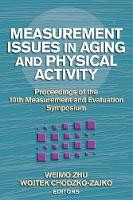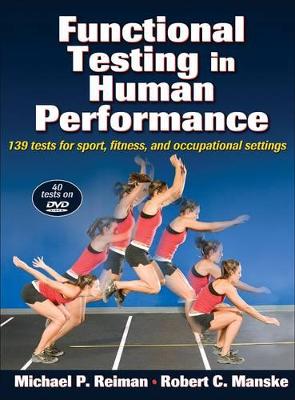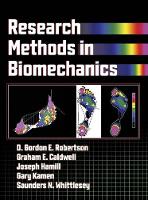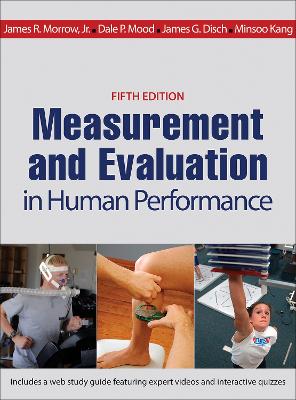Measurement Issues in Aging and Physical Activity
Measurement Issues in Aging and Physical Activity
Proceedings of the 10th Measurement and Evaluation Symposium
;
Human Kinetics Publishers
10/2005
208
Dura
Inglês
9780736053648
454
Descrição não disponível.
Part I: Critical Issues in Aging and Physical Activity Research Chapter 1. Human Gene Map, Physical Activity, and Aging Tuomo Rankinen, PhD -Genetics and Health-Related Fitness -Genetic Research Approaches: Candidate Genes Versus Genomic Linkage Scans -Genetics, Aging, and Health-Related Fitness -Summary and Conclusions Chapter 2. Physical Activity and Older Adults: Impact on Physical Frailty and Disability Miriam E. Nelson, PhD, FACSM, and Rebecca Seguin, MS, CSCS -Overview of the Health Benefits of Exercise and Older Adults -Initial Strength Training Research With Older Adults -Frailty and Falls -Bone and Joint Health -Endurance -Strength and Functional Performance -A Variety of Strength Training Prescriptions -The Potential of Power Training -Conclusion Chapter 3. Exercise Dose-Response Effects in Older Adults Roy J. Shephard -Relative Versus Absolute Intensity of Effort -Experimental Evidence -Some Problems of Research Design -Is Aerobic Fitness Enough? -Moderate or Intense Physical Activity: A Public Policy Debate -Consensus Recommendations -Systematic Review of Dose-Response Issues -All-Cause and Cardiovascular Mortality -Research Priorities Chapter 4. Control and Regulation of Movement in Elderly Adults Caroline J. Ketcham and George E. Stelmach -Movement Characteristics -Coordination -Skill Learning -Visual Monitoring -Concluding Remarks Chapter 5. Environment, Culture, and Physical Activity of Older Persons Uriel Cohen, Darch, and Ruth Cohen, PhD -Culture: A Working Definition -Active Living: A Working Definition -Benefits of Active Living: Contributions to Physical and Mental Health -The Problem: Barriers to Active Living -The Premise: Cultural Heritage As a Catalyst for Active Living -The Context of the Case Study: History, Culture, Demographics, and Economy -Conclusions Part II: Measurement Challenges in Aging Research Chapter 6. Physical Activity, Aging, and Quality of Life: Implications for Measurement Edward McAuley and Steriani Elavsky -Conceptualizing and Defining Quality of Life -Measuring Quality of Life in Physical Activity Research -Can Physical Activity Improve Quality of Life in Older Adults? -Can Physical Activity Improve Quality of Life in Cancer Patients? -Is There a Dose-Response Relationship for Physical Activity Effects on Quality of Life? -Issues to Consider in the Physical Activity and Quality of Life Relationship -Concluding Remarks Chapter 7. Assessment Issues Related to Physical Activity and Disability James H. Rimmer, PhD -Defining Disability -Importance of Physical Activity in Improving Function -Impact of the Environment on Health and Wellness -Measurement Issues in Disability and Physical Activity -Conclusion Chapter 8. Measuring the Ever-Changing "Environments" for Physical Activity in Older Adults James R. Morrow, Jr., PhD, and Dale P. Mood, PhD -Measurement Issues -Statistical Analysis -Sample Instrumentation Issues -The Challenge -Future Research Chapter 9. Translating Research to Practice: Real-World Evaluation and Measurement Issues in Moving From Efficacy to Effectiveness Research Marcia Ory, PhD, MPH; Diane Dowdy, PhD; Brigid Sanner; Robin Mockenhaupt, PhD, MPH; Laura Leviton, PhD; Russell Glasgow, PhD; Abby King, PhD; Cynthia Castro, PhD; Michele Guerra, MS, CHES; and Sara Wilcox, PhD -The Evolving Research Base -Principles of Behavior Change Research -Behavioral Change Consortium -Key Measurement/Methods Questions -Furthering Translational Research Chapter 10. Qi, Aging, and Measurement: History, Mystery, and Controversy Weimo Zhu, PhD -What Are Qi and Qi-Gong? -A Brief History of Qi-Gong -Qi-Gong and the World -Qi-Gong Schools and Classification -Mystery and Controversy Surrounding Qi-Gong -Qi-Gong and Health -Qi-Gong and Aging -Qi Measurements and Challenges -Future Research Directions Part III: New Measurement Methods and Techniques Chapter 11. Common Shape Models for Trend Curves Roderick P. McDonald -Common Shape Models -Conclusions Chapter 12. Emergent Technologies and Remote Clinical Assessment Leigh W. Jerome Part IV: Measurement in Kinesiology: Past, Present, and Future Chapter 13. Measurement and Evaluation Council: Past, Present, and Future Ted A. Baumgartner -Structure -Past -Present -Future Chapter 14. The Changing Face of the Measurement Specialist in Kinesiology Stephen Silverman -Coming Clean -Changes in the Measurement and Evaluation Field -Issues and Questions for the Future -Conclusion Appendix: Program of the 10th Measurement and Evaluation Symposium References About the Editors
Este título pertence ao(s) assunto(s) indicados(s). Para ver outros títulos clique no assunto desejado.
Part I: Critical Issues in Aging and Physical Activity Research Chapter 1. Human Gene Map, Physical Activity, and Aging Tuomo Rankinen, PhD -Genetics and Health-Related Fitness -Genetic Research Approaches: Candidate Genes Versus Genomic Linkage Scans -Genetics, Aging, and Health-Related Fitness -Summary and Conclusions Chapter 2. Physical Activity and Older Adults: Impact on Physical Frailty and Disability Miriam E. Nelson, PhD, FACSM, and Rebecca Seguin, MS, CSCS -Overview of the Health Benefits of Exercise and Older Adults -Initial Strength Training Research With Older Adults -Frailty and Falls -Bone and Joint Health -Endurance -Strength and Functional Performance -A Variety of Strength Training Prescriptions -The Potential of Power Training -Conclusion Chapter 3. Exercise Dose-Response Effects in Older Adults Roy J. Shephard -Relative Versus Absolute Intensity of Effort -Experimental Evidence -Some Problems of Research Design -Is Aerobic Fitness Enough? -Moderate or Intense Physical Activity: A Public Policy Debate -Consensus Recommendations -Systematic Review of Dose-Response Issues -All-Cause and Cardiovascular Mortality -Research Priorities Chapter 4. Control and Regulation of Movement in Elderly Adults Caroline J. Ketcham and George E. Stelmach -Movement Characteristics -Coordination -Skill Learning -Visual Monitoring -Concluding Remarks Chapter 5. Environment, Culture, and Physical Activity of Older Persons Uriel Cohen, Darch, and Ruth Cohen, PhD -Culture: A Working Definition -Active Living: A Working Definition -Benefits of Active Living: Contributions to Physical and Mental Health -The Problem: Barriers to Active Living -The Premise: Cultural Heritage As a Catalyst for Active Living -The Context of the Case Study: History, Culture, Demographics, and Economy -Conclusions Part II: Measurement Challenges in Aging Research Chapter 6. Physical Activity, Aging, and Quality of Life: Implications for Measurement Edward McAuley and Steriani Elavsky -Conceptualizing and Defining Quality of Life -Measuring Quality of Life in Physical Activity Research -Can Physical Activity Improve Quality of Life in Older Adults? -Can Physical Activity Improve Quality of Life in Cancer Patients? -Is There a Dose-Response Relationship for Physical Activity Effects on Quality of Life? -Issues to Consider in the Physical Activity and Quality of Life Relationship -Concluding Remarks Chapter 7. Assessment Issues Related to Physical Activity and Disability James H. Rimmer, PhD -Defining Disability -Importance of Physical Activity in Improving Function -Impact of the Environment on Health and Wellness -Measurement Issues in Disability and Physical Activity -Conclusion Chapter 8. Measuring the Ever-Changing "Environments" for Physical Activity in Older Adults James R. Morrow, Jr., PhD, and Dale P. Mood, PhD -Measurement Issues -Statistical Analysis -Sample Instrumentation Issues -The Challenge -Future Research Chapter 9. Translating Research to Practice: Real-World Evaluation and Measurement Issues in Moving From Efficacy to Effectiveness Research Marcia Ory, PhD, MPH; Diane Dowdy, PhD; Brigid Sanner; Robin Mockenhaupt, PhD, MPH; Laura Leviton, PhD; Russell Glasgow, PhD; Abby King, PhD; Cynthia Castro, PhD; Michele Guerra, MS, CHES; and Sara Wilcox, PhD -The Evolving Research Base -Principles of Behavior Change Research -Behavioral Change Consortium -Key Measurement/Methods Questions -Furthering Translational Research Chapter 10. Qi, Aging, and Measurement: History, Mystery, and Controversy Weimo Zhu, PhD -What Are Qi and Qi-Gong? -A Brief History of Qi-Gong -Qi-Gong and the World -Qi-Gong Schools and Classification -Mystery and Controversy Surrounding Qi-Gong -Qi-Gong and Health -Qi-Gong and Aging -Qi Measurements and Challenges -Future Research Directions Part III: New Measurement Methods and Techniques Chapter 11. Common Shape Models for Trend Curves Roderick P. McDonald -Common Shape Models -Conclusions Chapter 12. Emergent Technologies and Remote Clinical Assessment Leigh W. Jerome Part IV: Measurement in Kinesiology: Past, Present, and Future Chapter 13. Measurement and Evaluation Council: Past, Present, and Future Ted A. Baumgartner -Structure -Past -Present -Future Chapter 14. The Changing Face of the Measurement Specialist in Kinesiology Stephen Silverman -Coming Clean -Changes in the Measurement and Evaluation Field -Issues and Questions for the Future -Conclusion Appendix: Program of the 10th Measurement and Evaluation Symposium References About the Editors
Este título pertence ao(s) assunto(s) indicados(s). Para ver outros títulos clique no assunto desejado.






